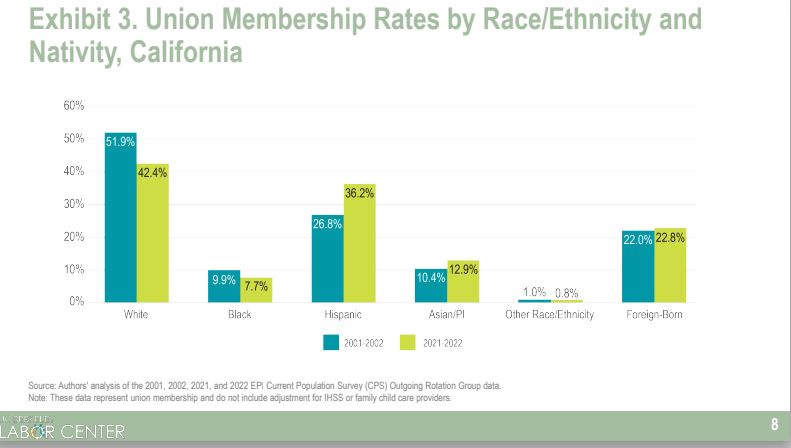
New analysis shows that ‘it’s not your grandfather’s union anymore’
A study by the UC Berkeley Labor Center finds that union members are more likely to be women and people of color than 20 years ago
September 5, 2023 – Berkeley, CA – A deep look at U.S. Census data shows that at least half of all of California’s 2.5 million union members are women and that the majority of all union workers are people of color. This shift in the portrait of union membership comes as a “hot union summer” across the state rolls into what promises to be an equally militant fall, with public support for unions higher than it has been since the 1960s.
Key findings from the California Union Membership and Coverage 2023 Chartbook include:
- Half of California’s union members are women.
- The majority of California’s union members are workers of color, reflecting the diversity of California’s workforce.
- Half of all union members in California work in the public sector.
- The share of workers in unions has been remarkably stable in California over the last two decades, as it continued to fall in the rest of the country.
Those statistics likely undercount women of color because that data does not include in-home supportive services (IHSS) workers and around 33,400 unionized family child care providers.
By contrast, 20 years ago the typical union member in California was a white man.
“While some of these changes might be due to the growing number of women and people of color in the California workforce as a whole, they also point to a conscious effort by the labor movement to organize immigrants, women, and people of color, particularly in service industries,” said Ken Jacobs, chair of the UC Berkeley Labor Center.
For example, in Southern California in the 1990s, Latino immigrants were key in the successful efforts to organize janitors and hotel workers. The successful organizing of home care workers in California was led by a workforce that is predominantly female and racially and ethnically diverse.
“The L.A. labor movement’s strength is in our diversity,” said Yvonne Wheeler, president of the Los Angeles County Federation of Labor. “These statistics tell a story that we already know well here in Los Angeles: the workers pushing our movement forward–hospitality workers, airport workers, government workers, nurses, janitors, teachers–are women, immigrants, and people of color.”
Hugo Soto, who spent 16 years organizing with UNITE HERE! before being elected to the LA City Council last year, points to these workers as the force behind the growth of the labor movement.
“From servers to housekeepers, despite constantly being overlooked by the wealthy and well-connected, it is women and workers of color leading the fight for livable wages and safe working conditions,” said Soto.
There are regional differences, too. In the San Francisco Bay Area, a third of union members are Asian/Pacific Islanders and in the Los Angeles Metro Area, almost half of union members are Latino.
The rate of union membership is holding steady in California as it declines in the rest of the country. While union density–or the percentage of unionization in the workforce–has fallen nationally for the last 20 years, in California it has been between 16-18% over the same time period. This is perhaps in part because public sector unions are strong, and because the industrial makeup of the state did not rely as heavily on manufacturing, as in the Rust Belt, for example.
While the data cannot predict the growth or decline of union membership in the coming years, the California Labor Federation has made new and inclusive organizing a key priority. The Labor Center will continue to keep an eye on the changing union demographics and union density in the state and hopes this recent data analysis will inform Labor Day coverage. For details see the California Union Membership and Coverage 2023 Chartbook and Snapshot of California Union Membership.
The UC Berkeley Labor is a public service and outreach program that conducts research and education on issues related to labor and employment.
Source: UC Berkeley Labor
This post was originally published on this site be sure to check out more of their content.








